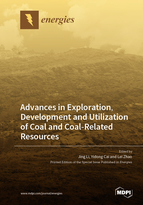Advances in Exploration, Development and Utilization of Coal and Coal-Related Resources
A special issue of Energies (ISSN 1996-1073). This special issue belongs to the section "H: Geo-Energy".
Deadline for manuscript submissions: closed (1 December 2022) | Viewed by 9633
Special Issue Editors
Interests: coal geology; critical elements in coal and coal combustion products (CCPs); coal geochemistry; coal mineralogy; environmental geochemistry of CCPs; sustainable and high value added utilization of CCPs
Special Issues, Collections and Topics in MDPI journals
2. Coal Reservoir Laboratory of National Engineering Research Center of Coalbed Methane Development & Utilization, Beijing 100083, China
Interests: geological process; energy geoscience; geo-energy resources evaluation; unconventional oil and gas source rock; reservoir fluids performance; micromechanical properties; scale-span structure; oil/gas/water adsorption/desorption
Special Issues, Collections and Topics in MDPI journals
Interests: mineral matter and trace elements in coal; strategically critical metals in coal-bearing sequences and coal combustion by-products; environmental impact of coal combustion by-products
Special Issues, Collections and Topics in MDPI journals
Special Issue Information
Dear Colleague,
The development of clean and low-carbon energy is undoubtedly imperative in the coming decades worldwide. Coal is definitely an indispensable source of energy necessary for techno-economic progress, currently accounting for 41% of global electricity needs. The combustion of a high volume of coal has led to the release of CO2, NOx, SO2 and toxic elements, as well as to the accumulation of huge amounts of coal combustion products (CCPs), which may pose severe threat to ecosystems. As a consequence, deep exploration and development, as well as the clean and efficient utilization of coal and coal-related resources (e.g., critical metals in coal, coal measure gases, etc.), is of great significance to achieve carbon neutrality. For instance, critical metals in coal and coal-bearing sequences have been a hot topic in the field of coal geology in recent years. The recovery of critical metals from coal and CCPs will contribute not only to the remission of global demand for strategic and critical metal resources but also to the clean and efficient utilization of coal. Meanwhile, research on the characterization and evaluation of coal measure gases, and other coal-related resources, will also greatly promote the development of low-carbon energy.
Thus, this Special Issue aims to discuss the advanced research on geological and geochemical characterization, as well as the exploration, development and utilization of coal and coal-related resources, especially critical metals together with unconventional gases in coal and coal-bearing sequences. We cordially invite authors to contribute either original research articles or review articles dealing with broad range of topics including, but not limited to, the following areas:
- Critical metals in coal and coal-bearing sequences: geological origin, modes of occurrence, and enrichment mechanisms;
- Recovery methods of critical metals from coal and CCPs;
- Characterization of coal measure gases;
- Novel methods or technologies for exploration and development of coal measure gases;
- Characterization and novel utilization of CCPs.
Dr. Jing Li
Prof. Dr. Yidong Cai
Prof. Dr. Lei Zhao
Guest Editors
Manuscript Submission Information
Manuscripts should be submitted online at www.mdpi.com by registering and logging in to this website. Once you are registered, click here to go to the submission form. Manuscripts can be submitted until the deadline. All submissions that pass pre-check are peer-reviewed. Accepted papers will be published continuously in the journal (as soon as accepted) and will be listed together on the special issue website. Research articles, review articles as well as short communications are invited. For planned papers, a title and short abstract (about 100 words) can be sent to the Editorial Office for announcement on this website.
Submitted manuscripts should not have been published previously, nor be under consideration for publication elsewhere (except conference proceedings papers). All manuscripts are thoroughly refereed through a single-blind peer-review process. A guide for authors and other relevant information for submission of manuscripts is available on the Instructions for Authors page. Energies is an international peer-reviewed open access semimonthly journal published by MDPI.
Please visit the Instructions for Authors page before submitting a manuscript. The Article Processing Charge (APC) for publication in this open access journal is 2600 CHF (Swiss Francs). Submitted papers should be well formatted and use good English. Authors may use MDPI's English editing service prior to publication or during author revisions.
Keywords
- coal
- critical metals
- coal combustion products
- unconventional resources
- modes of occurrence
- recovery methods
- CCP utilization
- coal-bearing sequences
- geological origin








